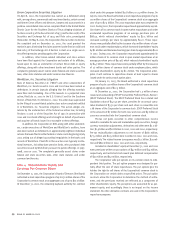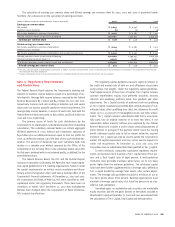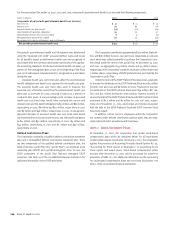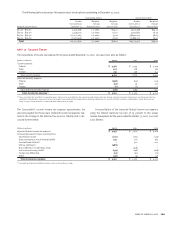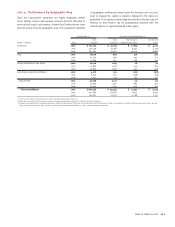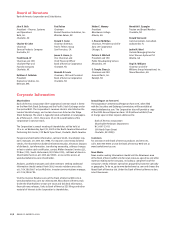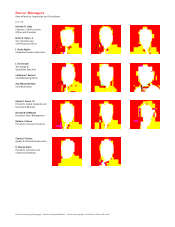Bank of America 2002 Annual Report Download - page 108
Download and view the complete annual report
Please find page 108 of the 2002 Bank of America annual report below. You can navigate through the pages in the report by either clicking on the pages listed below, or by using the keyword search tool below to find specific information within the annual report.
During 2002, the Corporation reached a tax settlement agree-
ment with the Internal Revenue Service. This agreement resolved
issues for numerous tax returns of the Corporation and various prede-
cessor companies and finalized all federal income tax liabilities
through 1999. As a result of the settlement, a $488 million reduction in
income tax expense was recorded resulting from a reduction in pre-
viously accrued taxes.
Significant components of the Corporation’s deferred tax (liabili-
ties) assets at December 31, 2002 and 2001 were as follows:
(Dollars in millions)
2002 2001
Deferred tax liabilities:
Equipment lease financing $ (5,817) $(6,907)
Investments (902) (559)
Securities valuation (531) (369)
Intangibles (457) (818)
State taxes (326) (457)
Available-for-sale securities (266) –
Depreciation (190) (166)
Employee retirement benefits (121) –
Deferred gains and losses (101) (92)
Employee benefits (69) (112)
Other (223) (104)
Gross deferred tax liabilities (9,003) (9,584)
Deferred tax assets:
Allowance for credit losses 2,742 2,991
Accrued expenses 428 482
Net operating loss carryforwards 347 143
Loan fees and expenses 91 93
Basis difference in subsidiary stock –418
Available-for-sale securities –311
Employee retirement benefits –56
Other 37 438
Gross deferred tax assets 3,645 4,932
Valuation allowance (114) (107)
Gross deferred tax assets,
net of valuation allowance 3,531 4,825
Net deferred tax liabilities $ (5,472) $(4,759)
The valuation allowance included in the Corporation’s deferred tax
assets at December 31, 2002 and 2001 represented net operating loss
carryforwards for which it is more likely than not that realization will
not occur and expire in 2004 to 2009. The net change in the valuation
allowance for deferred tax assets resulted from net operating losses
being generated by foreign subsidiaries in 2002 where realization is
not expected to occur.
At December 31, 2002 and 2001, federal income taxes had not
been provided on $899 million and $859 million, respectively, of
undistributed earnings of foreign subsidiaries, earned prior to 1987
and after 1997, that have been reinvested for an indefinite period of
time. If the earnings were distributed, an additional $198 million and
$188 million of tax expense, net of credits for foreign taxes paid on
such earnings and for the related foreign withholding taxes, would
result in 2002 and 2001, respectively.
NOTE 19 Fair Value of Financial Instruments
Statement of Financial Accounting Standards No. 107, “Disclosures
About Fair Value of Financial Instruments” (SFAS 107), requires the dis-
closure of the estimated fair value of financial instruments. The fair
value of a financial instrument is the amount at which the instrument
could be exchanged in a current transaction between willing parties,
other than in a forced or liquidation sale. Quoted market prices, if avail-
able, are utilized as estimates of the fair values of financial
instruments. Since no quoted market prices exist for certain of the
Corporation’s financial instruments, the fair values of such instru-
ments have been derived based on management’s assumptions, the
estimated amount and timing of future cash flows and estimated
discount rates. The estimation methods for individual classifications of
financial instruments are described more fully below. Different
assumptions could significantly affect these estimates. Accordingly, the
net realizable values could be materially different from the estimates
presented below. In addition, the estimates are only indicative of the
value of individual financial instruments and should not be considered
an indication of the fair value of the combined Corporation.
The provisions of SFAS 107 do not require the disclosure of the
fair value of lease financing arrangements and nonfinancial instru-
ments, including intangible assets such as goodwill, franchise, and
credit card and trust relationships.
Short-Term Financial Instruments
The carrying value of short-term financial instruments, including cash
and cash equivalents, time deposits placed, federal funds sold and
purchased, resale and repurchase agreements, commercial paper
and other short-term investments and borrowings, approximates the
fair value of these instruments. These financial instruments generally
expose the Corporation to limited credit risk and have no stated
maturities or have an average maturity of less than 30 days and carry
interest rates which approximate market.
Financial Instruments Traded in the Secondary Market
Held-to-maturity securities, available-for-sale securities, trading
account instruments, long-term debt and trust preferred securities
traded actively in the secondary market have been valued using
quoted market prices. The fair values of securities and trading
account instruments are reported in Notes 3 and 4.
Derivative Financial Instruments
All derivatives are recognized on the balance sheet at fair value,
taking into consideration the effects of legally enforceable master
netting agreements which allow the Corporation to settle positive
and negative positions with the same counterparty on a net basis. For
exchange traded contracts, fair value is based on quoted market
prices. For non-exchange traded contracts, fair value is based on
dealer quotes, pricing models or quoted prices for instruments with
similar characteristics. The fair value of the Corporation’s derivative
assets and liabilities is presented in Note 5.
106 BANK OF AMERICA 2002




